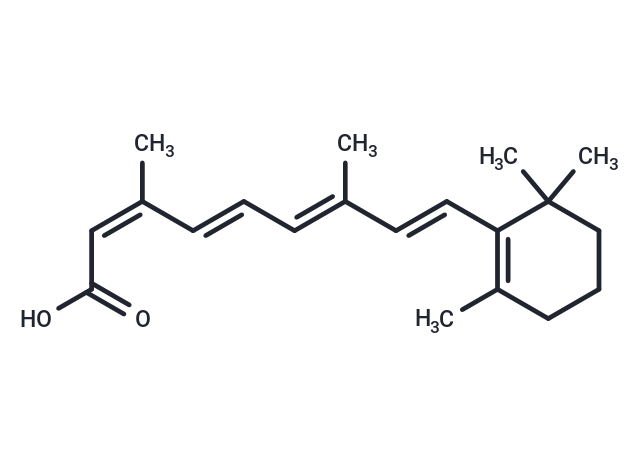Shopping Cart
- Remove All
 Your shopping cart is currently empty
Your shopping cart is currently empty

Isotretinoin (13-cis-Retinoic acid) binds to and activates nuclear retinoic acid receptors (RARs), which act as transcription factors that promote cell differentiation and apoptosis. This naturally occurring retinoic acid has potential antineoplastic activity, exhibits immunomodulatory and anti-inflammatory responses, and inhibits ornithine decarboxylase, thereby decreasing polyamine synthesis and keratinization.

| Pack Size | Price | Availability | Quantity |
|---|---|---|---|
| 50 mg | $36 | In Stock | |
| 100 mg | $50 | In Stock | |
| 200 mg | $67 | In Stock |
| Description | Isotretinoin (13-cis-Retinoic acid) binds to and activates nuclear retinoic acid receptors (RARs), which act as transcription factors that promote cell differentiation and apoptosis. This naturally occurring retinoic acid has potential antineoplastic activity, exhibits immunomodulatory and anti-inflammatory responses, and inhibits ornithine decarboxylase, thereby decreasing polyamine synthesis and keratinization. |
| In vitro | Isotretinoin directly interferes with the development of cranial neural crest cells. [1] Isotretinoin selectively affects neural crest cells by decreasing their cell-substratum adhesion. [2] |
| In vivo | Isotretinoin (500 ng/mL) and its main metabolite in the human, 4-oxo-isotretinoin, induce malformations similar to those seen in vivo. [1] Isotretinoin impairs explicit memory in Stage 2, but retention tests one month after Isotretinoin exposure ended, indicated recovery from this explicit memory impairment and evidence of enhanced implicit memory in the 10 mg and 15 mg ISO rats. [3] Isotretinoin slows the recovery of rod signaling after exposure to an intense bleaching light, and that rhodopsin regeneration is markedly slowed. Isotretinoin is also found to protect rat photoreceptors from light-induced damage. [4] Isotretinoin blocks the formation of A2E biochemically and the accumulation of lipofuscin pigments by electron microscopy. Isotretinoin also blocks the slower, age-dependent accumulation of lipofuscin in wild-type mice. [5] |
| Alias | 13-cis-Retinoic acid |
| Molecular Weight | 300.44 |
| Formula | C20H28O2 |
| Cas No. | 4759-48-2 |
| Smiles | C(=C/C(=C/C=C/C(=C\C(O)=O)/C)/C)\C=1C(C)(C)CCCC1C |
| Relative Density. | 1.011 g/cm3 |
| Storage | Powder: -20°C for 3 years | In solvent: -80°C for 1 year | Shipping with blue ice. | ||||||||||||||||||||||||||||||||||||||||
| Solubility Information | Ethanol: 1 mg/mL (3.32 mM), Heating is recommended. DMSO: 45 mg/mL (149.78 mM), Sonication is recommended. | ||||||||||||||||||||||||||||||||||||||||
Solution Preparation Table | |||||||||||||||||||||||||||||||||||||||||
Ethanol/DMSO
DMSO
| |||||||||||||||||||||||||||||||||||||||||

Copyright © 2015-2025 TargetMol Chemicals Inc. All Rights Reserved.